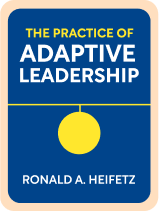

This article is an excerpt from the Shortform book guide to "The Practice of Adaptive Leadership" by Ronald A. Heifetz. Shortform has the world's best summaries and analyses of books you should be reading.
Like this article? Sign up for a free trial here .
What is organizational purpose? Do you feel like you often lose sight of your purpose as change gets in the way?
Organizational purpose is the grand vision of an organization that pulls its different functions together. Although most businesses will have a purpose, many struggle to stay true to it as circumstances get in the way.
There are five techniques to stay true to your and your organization’s orienting purpose as you navigate change.
Technique #1: Regularly Remind Yourself of Your Purpose
It’s common for everyday life to get in the way of your purpose, but when you put your purpose on the back burner, your life starts to lose meaning. Here are some ways to keep your purpose at the forefront of your mind:
1. Use a physical object to symbolize your organizational purpose. Choose something you see every day, and for extra accountability, something that’s public, so people will check in with you about your progress.
- (Shortform example: If your purpose is to keep your family safe and healthy, you might put a picture of your children in your wallet.)
2. Add purpose reminders to existing rituals. You already have rituals in your personal and professional life that you do regularly—if you can imbue them with purpose, you’ll encourage yourself to connect with it regularly.
- For example, if holding a staff meeting every Tuesday morning is a ritual for your organization, you might add an extra five minutes to the agenda to discuss purpose.
3. Start new rituals. You can design a ritual entirely around a purpose.
- For example, when Alexander’s purpose was to get physically stronger, he created a ritual in which every time he saw a TV ad for a health product, he did push-ups.
Technique #2: Reconcile Organizational Purposes
Everyone in your organization holds purposes, and they may not all be the same. Figuring out how these purposes all fit together will prevent them from conflicting with each other as you tackle adaptive change.
Reconciling purposes can be uncomfortable—giving ground feels disloyal to the purpose—but your only other choices are to keep quiet about your purpose (and make no change) or leave the organization for one that shares the same purpose.
Here are the steps to reconciling purposes:
1. Determine other people’s purposes. To do this, consider the organization from their perspective—what are their priorities?
2. Share your purposes concretely and specifically. Observe how everyone else reacts.
3. Reconcile. Tweak your purpose so it better matches up with everyone else’s. (This isn’t abandoning what you stand for; it’s a way of getting things done). You might:
- Move in a more roundabout way towards your purpose. For example, a car company’s environment manager’s purpose is to develop an emissions-free vehicle. She may have to additionally embrace the purpose of profit so that the company can stay open long enough to develop her dream vehicle.
- Sacrifice parts of your purpose. For example, Alexander and his wife have different ideas on how to best parent. Alexander has had to stop some of the practices that conflict with his wife’s.
- Frame your purpose in a new way to appeal to those who are skeptical or oppose you. For example, if your purpose is to reform the healthcare system, when you present your ideas to conservatives, tell them about how the reform will save money (versus the moral argument you might use on liberals).
Technique #3: Reflect on Ethics
The third technique is to consider how far you’re willing to go to achieve your purpose, because pursuing your purpose can lead to ethical dilemmas. For example, if the most effective intervention is to do something morally questionable, should you do it?
There’s no formula to determine the ethical benefits and costs when choosing a course of action—you have to decide for yourself. Consider the following two factors when making your decision:
1. Scope of harm to others. As we’ve learned, adaptive change inevitably creates a loss for certain parties. Consider how much harm you’re prepared to do in the name of your purpose.
- For example, Abraham Lincoln knew that people would die in the Civil War, but his purpose of saving the union was worth it to him.
2. Scope of harm to yourself. When you sacrifice a value or loyalty, you’ll damage your self-image. Consider how much harm you’ll wreck on yourself if you do things that feel wrong.
- For example, if one of your values is “theft is immoral,” but your children are starving, you might be willing to violate that value in the service of your purpose of protecting your children. If the circumstances aren’t so dire and you steal food, you might feel bad about yourself.
Re-evaluate the costs and benefits every time your purpose brings up an ethics conundrum because if you unilaterally decide the ends always justify the means, you’ll do more harm than you need to.
Technique #4: Hold Both Purpose and Ambition
The fourth technique for maintaining your momentum during adaptive change is to embrace your ambitions and your purpose to authentically be your whole self.
You might feel embarrassed about your purpose (some industries paint purpose-servers as “do-gooders”) or guilty about your ambitions (some industries frown on the selfishness required in ambition). Don’t let these feelings limit you—there’s no reason you can’t serve both your ambition and a purpose that goes beyond yourself. Sometimes there will be moments of conflict (for example, you need to work late one night so can’t spend time with your family) but for the most part, you can have both.
Technique #5: Avoid Pitfalls
The last technique to maintain your purpose is to watch out for traps. There are four pitfalls to avoid when it comes to serving your purpose:
1. Single-mindedness. When you get so committed to your purpose that you can’t see beyond it, you start to become insensitive to opposition and compromise, which could ultimately doom your purpose.
- For example, when the Clintons proposed radical healthcare reform, they were so single-minded about it that they couldn’t see that it would never pass. Instead of amending it to make it less threatening, they stuck to their initial proposal, and it didn’t go through.
2. Martyrdom. Being “killed” (fired, in a professional context) for your purpose might be something you’re willing to risk if you’re truly committed to it. However, martyrdom doesn’t further your purpose—once you’re out of the way, people can forget about you and your purpose, and it’ll never be realized.
3. Self-righteousness. If you’re so vocal about your purpose and its rightness that you annoy people, they can become resistant to it for three reasons:
- They like to oppose things.
- They’ve had bad experiences with self-righteous authority in the past.
- They can’t take any ownership of the purpose because you have it all.
4. Overemphasis. People will get tired of talking about the purpose if you bring it up too often. Only remind them of it when it’s relevant.

———End of Preview———
Like what you just read? Read the rest of the world's best book summary and analysis of Ronald A. Heifetz's "The Practice of Adaptive Leadership" at Shortform .
Here's what you'll find in our full The Practice of Adaptive Leadership summary :
- How to deal with unknown solutions that require innovation, experimentation, and adaptation
- How to determine if a problem is technical or adaptive
- Five tips for launching initiatives to address adaptive challenges






